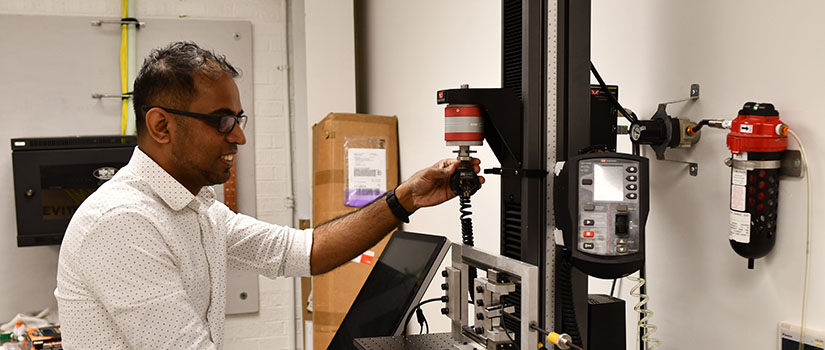CEC professors aim to better identify defects in aerospace, automotive and military manufacturing.
The advanced adhesion-driven composite manufacturing process, such as automated tow placement (ATP), has been utilized for more than 20 years, often in the aerospace industry to make Boeing 787 fuselages and wing structures. The automotive and military sectors are also interested in the process due to the potential for improved productivity and reduced material waste.
While ATP is a well-established process, there are opportunities for improvements in quality and the speed of manufacturing. Mechanical Engineering Assistant Professor Subramani Sockalingam and Distinguished Professor Michael Sutton recently began a four-year research project that will examine process-material interactions during adhesion-driven manufacturing to improve quality and reduce costs.
Sockalingam’s research, “Fundamental Studies of Process-Material Interactions in Advanced Adhesion-Driven Manufacturing with Automated Placement of Uncured Thermoset Tows as Model Process,” is funded by a $651,725 grant from the National Science Foundation. The award will provide guidelines for the automated tow placement manufacturing process, enabling better process simulations and enhanced composite part quality.
“By better understanding how defects form, we’re trying to improve the quality of the products that are manufactured through this process. This can benefit industry because they’re reducing inspection time, which leads to lower costs and cycle time that allows the parts to be made faster,” Sockalingam says.
Automated tow placement is an adhesion-driven manufacturing process for polymer matrix composites. A bundle of fibers infused with resin (known as a tow) is placed onto a tool or previously placed tow. But the process requires high temperature and pressure, which can result in defects (wrinkles, folds) that damage composite bond strength and cause premature component failure. Sockalingam’s research will focus on how bonding is created during the process and how defects form.
“We can minimize the defects to improve the quality of the composite parts. Then we can reduce the time that's involved in inspecting whether the defects are forming,” Sockalingam says. “It also improves part quality while reducing the overall cost associated with the remanufacturing of defective components.”
The research will also aim to produce novel composite materials with improved properties. This includes the opportunity to improve current composite materials’ resistance to fracture.
“The fiber composites are somewhat brittle in nature, so we’ll try to incorporate novel architectures by manipulating fiber orientations in the composite material,” Sockalingam says. “We’ll use a 3D printer to explore a variety of new architectures to understand how they will behave under different load conditions.”
The mechanics and manufacturing of composite materials will be another focus of Sockalingam’s research. Mechanics refers to how the material will behave under different loading conditions, such as how a material responds when subjected to impact loading. Manufacturing implies working toward improving the quality of the composite materials. Sockalingam will apply his previous research with the Army Research Lab to understand how ballistic fibers and composites used in body armor systems behave under complex impact load conditions.
“For the Army, it’s important to have lightweight systems so people wearing them can easily move around,” Sockalingam says. “By fundamentally understanding how these material systems behave under complex load conditions, we can apply that knowledge to improve the products and components to make them lightweight.”
Sockalingam also intends to eliminate a knowledge gap by investigating the fundamentals of how bond strength-toughness develops and how defects form during contact and adhesion of uncured, polymer-rich materials. Specifically, millisecond time scales will be tested using parameters discovered from novel experiments.
“During the process, it's only about 10 to 50 milliseconds during which the bond is created between the two layers that are being pressed together at high pressure and temperature. We want to understand how the bond is forming and how the defects are produced at such short time scales,” Sockalingam says.
Aside from the research, NSF projects also have criteria for broader impacts and how the project addresses societal needs, such as incorporating underrepresented groups and applying the research to coursework. Sockalingam has a plan to accomplish these goals.
“We will make a specific effort to recruit graduate and undergraduate students from underrepresented groups through the Society for Women Engineers at the University of South Carolina,” Sockalingam says. “In addition, a module on automated tow placement manufacturing and process simulations developed in this research will be incorporated into a composite manufacturing course to provide knowledge on the governing process-structure-property links for design and manufacturing.”
Sockalingam believes his research methods are part of the future of manufacturing, especially the increased use of 3D printing and additive manufacturing. He hopes his research can help answer some questions about the uncertainties of utilizing the adhesion-driven composite manufacturing process with automated tow placement.
“It's so fundamental in nature that once we understand the physics when we bond two materials under complex work conditions, it becomes applicable to a variety of additive manufacturing situations,” Sockalingam says. “This is unique because it's not attached to one specific manufacturing process. Rather, understanding the fundamentals of how polymers bond and defects are produced makes it applicable to so many different processes.”
